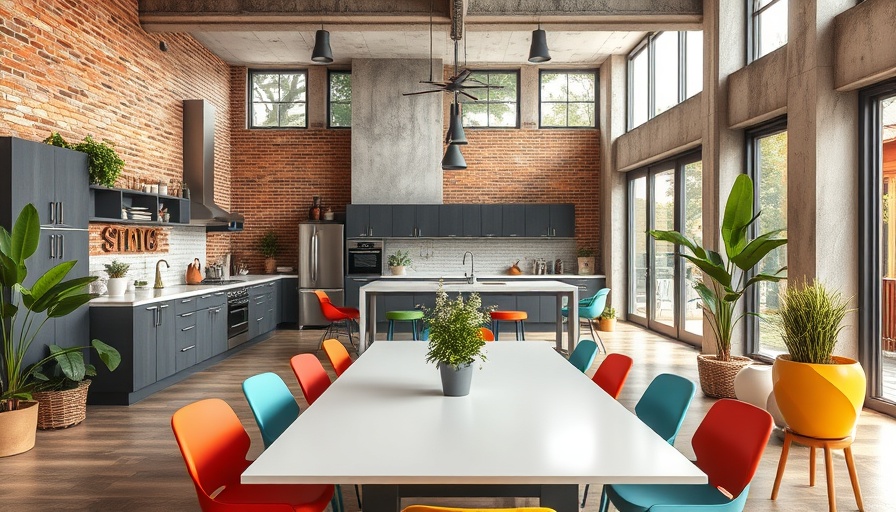
Embracing Nature in Urban Living
In the bustling heart of East London, a serene sanctuary known as Catching Sun House offers a unique perspective on urban living. Designed by architect Mark Shaw of Studioshaw, this home exemplifies how modern architecture can harmonize with nature, delivering both aesthetic beauty and sustainable functionality. As cities continue to grow, the need to incorporate greenery and sustainable practices into residential design becomes paramount.
The Concept of Biophilic Design
Biophilic design refers to the integration of natural elements into built environments, promoting a connection with nature that enhances well-being. Catching Sun House brilliantly implements this concept through its use of natural materials and strategically designed windows and skylights that maximize sunlight and provide breathtaking views of the surrounding greenery. This not only enriches the living experience but also contributes to mental and emotional health, making it suitable for families and individuals alike.
A Thoughtful Layout: Three Distinct Courtyards
One of the most intriguing features of Catching Sun House is its innovative layout, centered around three separate courtyards. Each courtyard serves a unique purpose and microclimate: one stands as a cozy winter retreat, another fosters local biodiversity, and the third acts as a picturesque transitional space. This thoughtful design emphasizes the importance of outdoor connections and sustainable living, allowing residents to engage with nature in various ways throughout the year.
Landscape Architect Meets Sustainable Design
Collaboration with award-winning landscape designer Charlie Hawkes has resulted in a project that goes beyond traditional home design. The rich landscaping weaves through and around the house, creating continuity between indoor and outdoor spaces. This seamless transition not only enhances the property's aesthetic appeal but also plays a crucial role in preserving local wildlife and promoting biodiversity. Nature becomes a partner in this design, enriching the experience for occupants as well as the local ecosystem.
Natural Materials and Harmonized Design
The aesthetic of Catching Sun House is punctuated by its organic materials—timber, exposed concrete blocks, and anodized aluminum—creating a sensory experience that aligns with the surrounding flora. This choice of materials resonates with global architectural trends that favor sustainability without sacrificing style. Each element has been carefully selected not just for its beauty but for its ability to contribute to the home's energy efficiency, reducing carbon footprints while creating inviting spaces for relaxation.
The Allure of an Outdoor Shower
How often can one combine the pleasures of bathing with an immersive outdoor experience? The glass-enclosed outdoor shower at Catching Sun House is not only a delightful design feature but also serves a practical purpose. Set within the home’s eastern courtyard and designed to capture optimal sunlight in the morning, it transforms daily routines into rejuvenating rituals. This thoughtful touch underscores the home's dedication to creating tranquil moments amidst the hustle and bustle of city life.
Green Spaces: Enhancing Urban Living
In an era where rapid urbanization threatens green spaces, the innovative design of Catching Sun House serves as a reminder of the importance of integrating nature within urban settings. Facilities like this challenge the notion that city living must come at the expense of nature, demonstrating that tranquility and lush living can coexist alongside urban excitement. By prioritizing green spaces and biophilic elements, urban planners and architects can redefine how we interact with our environments.
Practical Insights for Homeowners and Contractors
Homeowners seeking to bring elements of nature into their own spaces or contractors looking to expand service offerings can draw lessons from this design. Simple actions, like incorporating more plants, maximizing natural light with strategic window placement, and using sustainable materials, not only add aesthetic appeal but also enhance the utility of a space. Whether through small DIY projects or larger renovations, every effort counts toward creating a harmonious living environment that respects both individual needs and environmental sustainability.
Actionable Insights To Create Your Green Retreat
If you are inspired by the balance of nature and architecture at Catching Sun House, consider this a call to action. Evaluate your living space: Are there opportunities to include greenery or improve natural light? Small changes can greatly influence your daily life and mental well-being. From indoor gardens to redesigned outdoor spaces that invite nature in, letting greenery flourish will not only enhance your home but will also contribute to a healthier planet.
Concluding Thoughts: A Green Legacy for Future Generations
As urban growth continues, the principles highlighted by Catching Sun House stand as an essential guide for future developments. Integrating natural elements within our living spaces is not just an aesthetic choice; it is an avenue towards sustainable living. By recognizing our interconnectedness with nature through biophilic design, we set a precedent for future generations to enjoy the beauty and benefits that come with thoughtfully designed green spaces.
 Add Row
Add Row  Add
Add 




Write A Comment